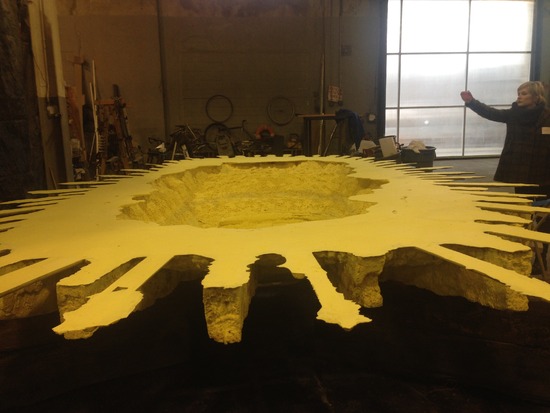Last weekend I was lucky for the opportunity to join a group of fellow parents for a tour of Matthew Barney’s studio and a preview of a couple of clips from his new film, River of Fundament. I don’t like to type “film” because Barney isn’t really a filmmaker, although virtually his entire output has been structured around films, most notably the Cremaster series. Barney is really a sculptor, in the contemporary sense in that he is inspired by research, process-intensive, and certainly highly conceptual. He is the heir of Duchamp, Beuys, and Serra. The new work has a strong operatic quality (literally, with a sung libretto). I asked if he would ever be interested in live performance, and he said no— he wouldn’t be able to get the closeups he needs. This says a lot about his filmmaking: The films are highly composed, choreographed views of sculpture and performance. They are not visual storytelling. Yes, this could be said about most “video art,” but with Barney there is enough of a narrative thread and cinematography that people often view him as a filmmaker.
This project (the film is 5.5 hours long,
showing next month at BAM with intermissions…) embodies the Barney process: he started with a Norman Mailer novel,
Ancient Evenings, set in pharaonic Egypt and which Mailer had suggested to Barney before the author’s death (Barney worked with Mailer on
Cremaster 2). We have themes of ancient egypt, crypts and pyramids, a theme of Mailer’s wake in his Brooklyn Heights home. Barney unpacks the essence of his motifs — they seem to be formally connected by linking Mailer’s writing aerie and an ancient pyramid, and thus we get the ambitious sculptural objects we saw in Barney’s studio (shown in these pictures).

Barney is the deepest, most metaphysical, and probably the most important artist of our generation. He absorbs themes that interest him, often starting from a geographical place, examining historical events, archetypes, traditions. Rituals are transformed and abstracted until they begin to represent systems of different scales— societal, geological, sexual. He gets at the way systems overlap and repeat themselves at different scales. Think of a goofy science video, say, about the mammalian circulatory system. People wearing puffy red costumes represent the red blood cells, carrying little bubbles of oxygen. Silly looking, but drawing parallels between human activity and cellular activity. My mind always feels expanded after experiencing the work.

In portraying these scenarios, Barney creates iconic objects, elaborate props that are replete with symbolic references. These sculptures are typically fascinating and beautiful— industrial, biological, baroque. This beauty, along with a peculiar confidence and determination usually evident in the characters performing in the scenarios, suggest that these systems in equilibrium are in a way perfect, the highest forms of life. In fact in this beauty there is more than a glimmer of decadence— are we observing the rituals of highly developed systems just before they collapse?

